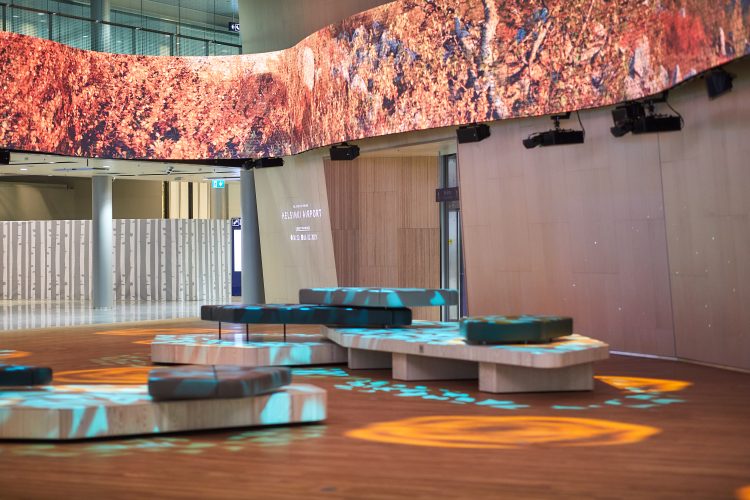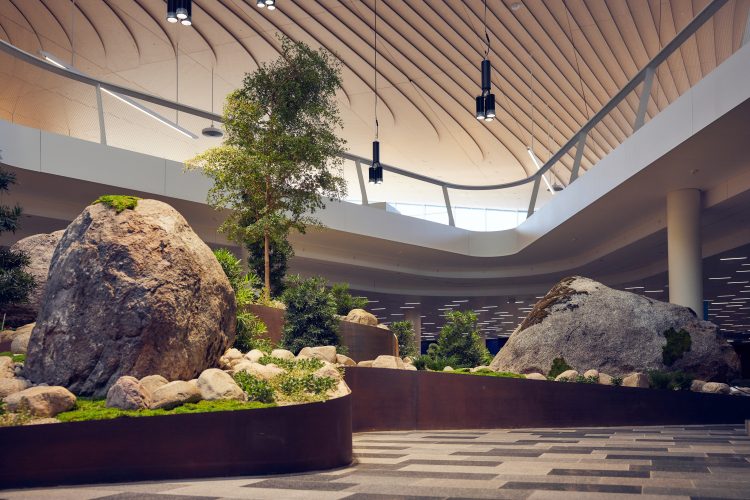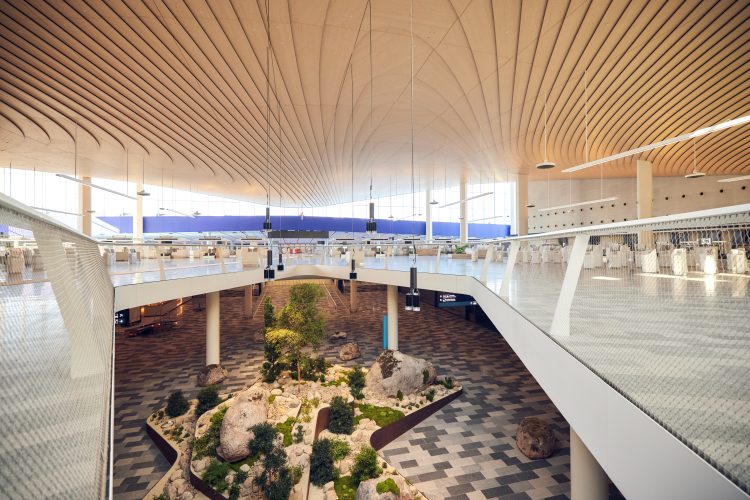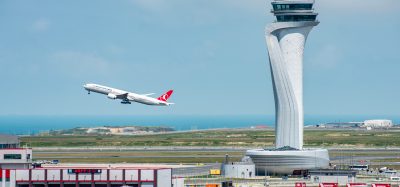Finding ‘Finnspiration’ in Helsinki Airport’s new development
- Like
- Digg
- Del
- Tumblr
- VKontakte
- Buffer
- Love This
- Odnoklassniki
- Meneame
- Blogger
- Amazon
- Yahoo Mail
- Gmail
- AOL
- Newsvine
- HackerNews
- Evernote
- MySpace
- Mail.ru
- Viadeo
- Line
- Comments
- Yummly
- SMS
- Viber
- Telegram
- Subscribe
- Skype
- Facebook Messenger
- Kakao
- LiveJournal
- Yammer
- Edgar
- Fintel
- Mix
- Instapaper
- Copy Link
Posted: 31 May 2024 | Holly Miles | No comments yet
International Airport Review’s Editor Holly Miles, was invited by Finavia to see the renewed Helsinki Airport after the historic development programme. Here, she reports back on the results of this monumental project.
They say that good things come to those who wait. And the Helsinki Airport development programme, which was successfully completed in the autumn of 2023 after spanning a decade and costing over €1 billion, was certainly a long time in the making. But the results have been fantastic.
The historic development programme, the largest extension project in Finavia’s history, brings the airport together under a single roof concept and aims to position the airport’s facilities as among the best in the world.
The programme saw the expansion of the Schengen gate area; border control; gate areas and the building of a new departure hall and security control area; transfer baggage hall, west pier, south pier, parking hall and new gates. The terminal has expanded by a whopping 45%; the apron area by 13% and the parking by 19%.
Customer and airline experience
The aim of the programme was to create more space for the rising numbers of passengers (specifically Asian travellers) flowing through the airport and to make the airport experience smoother. Helsinki is now capable of serving 30 million passengers annually.
Finavia also strongly considered airline customers in the content of the development programme. Thanks to the expanded apron, new aircraft parking spaces, passenger bridges and increased baggage handling capacity, airlines can operate smoothly at Helsinki-Vantaa and serve customers better.
“The customer experience has been the core of the whole programme from the beginning, and we have made huge progress from the customer perspective in all our areas of the development programme. From the airline experience, our infrastructure, our gates, our bridges, our apron, our runways, are in a very good condition and the airlines have better facilities which will increase their efficiency,” said Ulla Serlenius, Senior Vice President of Finavia, speaking exclusively to International Airport Review.
Something that is unique about the Helsinki Airport traveller journey is that when passengers exit security controls, they are not funnelled straight out into Duty Free, as you see in so many airports. They are given the choice of where to go once they have passed security, which is really refreshing.
The acoustics within the departure hall are quiet and soft, even when it is busy, feeding into a sense of calm. There is also a quiet room equipped with prayer mats and a compass on the floor, as well as a yoga room for passengers looking to spend a quiet moment by themselves, away from the hustle and bustle of the main airport terminal.
Aukio: a window to Finland
My favourite part of the terminal was a big open space with seating, encircled by a strip of LED screens showing scenes and sounds from natural Finland, named Aukio, and was designed by Finnish firm OiOi.
Coming out from the security screening and walking through the terminal, you feel as if you have stumbled into a clearing. As you take a seat, you look around and experience a sense of calm, soothed by the sound of wind and birdsong. It reminds you to connect with nature – something a lot of city dwellers don’t do these days.
In 24 hours, the space presents all four seasons with 16 different landscapes and nature scenes. Within the space of a day, you can experience the magical polar night, the awe-inspiring northern lights, bright summer days, spring days and autumnal sunsets.
A nearby wall displays the location of the scene, the time of day and time of year. Passengers are also able to interact with the scenes by creating different animations with the northern lights and effects such as falling leaves. This creates a connection between the space and the passenger, which is so unique and special to the experience and something I have never seen before in an airport.
Finnish design
The design and implementation of Helsinki Airport’s new terminal was guided by Finnishness, Finnish nature and sustainable choices. Attention has been paid to domestic materials, energy-saving solutions and reducing the carbon footprint of construction.
When entering the arrivals hall, passengers are greeted by Luoto, a nature element with rocks, plants which is meant to give the feel of a Finnish islet. The impressive wooden ceiling, which has already claimed Puuinfo’s Wood Award in 2022, is made from Finnish Spruce and consists of more than 500 individual elements.
“Finnish nature inspired the interior design of the terminal. The Luoto green structure of the arrival’s hall welcomes passengers to Finland as soon as they step out of the baggage claim hall. On the other hand, the stunning wooden ceiling of the departures hall, made entirely of Finnish spruce, creates a calm atmosphere right at the beginning of one’s trip,” said Ulla Serlenius, Finavia’s SVP, Helsinki Airport.
The employment effect of this programme was the equivalent of almost 17,000 person-years and the programmes content is 90% Finnish.
Sustainability
Helsinki city’s target is to become carbon neutral by 2030, and its goals cover sectors such as construction, events and travel.
Helsinki is currently ranked as the fourth most sustainable tourist destination in the world in the Global Destination Sustainability (GDS) Index, which was published on 4 October 2023. However, they do not plan to rest on their laurels as the city has set an ambition to reach the top of this index by 2025 by becoming the smartest and most sustainable travel destination in the world.
Nina Vesterinen, Tourism Director at the City of Helsinki, said: “One of Helsinki’s main goals in the development of tourism is to become the world’s most sustainable travel destination. The fact that our ranking rose by eight places from last year is a sign that we are doing the right things. Our goal to be the world’s most sustainable travel destination is already within reach. For this, we owe big thanks to all our stakeholders – above all to those companies that are pioneers in sustainability.”
Helsinki Airport is carbon neutral and will be reducing carbon emissions to net zero level in 2024. The airport has three solar mills that create clean energy, and the terminal is 30% more efficient than regulations require. The new development programme has also seen new capacity of 300 charging places for electric cars – 100% supplied by solar panels on the roof of the car park.
Next-gen security control
In spring 2022, Finavia implemented next‑generation security control technology at Helsinki Airport. The technology has revolutionised the way security control operates at Helsinki Airport, providing passengers with a smoother and more relaxed start to their journey. Unlike most airports worldwide, passengers now no longer need to remove their large electronics or liquids from their hand baggage and are even allowed to take up to two litres of liquid – an increase from the previously allowed 100ml.
These developments not only enhance the experience, but also allow security staff to work more efficiently. At full capacity, the new security control lines can service twice as many passengers as the old ones, further streamlining the airport’s operational processes and improving the passengers’ travelling experience.
The airport has 10 state-of-the-art security control lines equipped with cutting-edge technology based on computed tomography. The 920CT equipment, manufactured by the security screening provider Rapiscan Systems, creates 3D images which allows security staff to rotate the images from a full 360-degree view. The CT technology, originally utilised in the medical field, has revolutionised the way security screenings are conducted at Helsinki Airport.
Ari Kumara, Vice President for Security at Finavia Corporation, said: “Helsinki Airport’s experience serves as a shining example of how investments in technology and infrastructure can yield substantial returns, not just in passenger satisfaction, but also in operational efficiency and security.
“As a leading figure in our industry regarding service development, our commitment to serving passengers as effectively as possible has resulted in a significant step forward for the aviation industry. The implementation of next generation security control technology at Helsinki Airport sets a new standard for enhancing passenger experience and reinforces the airport’s position as a leader in innovation and passenger satisfaction. As other airports observe the success of Helsinki Airport’s advancements, they may seek to adopt similar cutting-edge technologies to elevate their own passenger experiences to new heights.”
With the old technology, they were able to process 100 passengers per hour. However, now, a lot of security staff work remotely and with the new technology, they can process 300 passengers an hour.
Industry accolades
In June 2023, Helsinki Airport won the award for best European airport of 2023 in its size category granted by the Airports Council International (ACI). In spring 2022, Helsinki Airport also received the international ASQ (Airport Service Quality) award for Europe’s best airport, an award based on passenger interviews and assessments of passenger satisfaction and airport service quality – an award that Helsinki has won three times between 2018 and 2022. The airport has also been selected by Skytrax World Airport Awards as ‘Best airport in Northern Europe’, five times between 2016 and 2023.
As if the above awards weren’t enough, Helsinki was also selected as one of the world’s most beautiful airports by the internationally renowned Prix Versailles 2023 architecture and design competition. The award criteria included innovation, creativity, consideration of local natural and cultural heritage in the design and eco-friendliness. In last year’s competition, Helsinki Airport received an award for the interior design of the redeveloped terminal. The awards were given for the steel structure and building information modelling of the terminal building, the spectacular wooden ceiling of the departures hall and sustainable construction, among other things.
Innovation
Innovation in the airport experience is evident in the number of initiatives that they have implemented.
In August 2023, the airport opened Relove, the world’s first second-hand concept store located at an airport. The store has an in-house café serving coffee, cake and avocado toast, among other items. Airports are quite often home to luxury brands which are unaffordable to most passengers; Finavia’s endorsement of pre-loved fashion shows that airports are not above second-hand fashion, hopefully setting a precedent for other airports around the world to help normalise reusing materials and shopping second-hand.
Winter sun seekers among you will agree that travelling to the airport in your winter coat is not ideal, especially if you are travelling to destinations like the Bahamas. However, at Excess Baggage Company, you can leave your bulky items such as winter coats in storage and pick up on your way home.
Recognising that passengers are often impatient to get home or to their hotel, Finavia has partnered with food delivery app Wolt. In the Wolt app, you can now order food from the airport’s restaurants to pick up yourself in the arrival’s hall, or have it delivered to nearby offices and homes. On the app you can find restaurants such as Pretty Boy Wingery, Bär Bar, Richie’s Gourmet Hot Dogs, Levant, Burger King and Subway, all of which are located in the arrival’s hall of the airport.
“Sisu”
In the Finnish language “Sisu”, is a word that means strength and perseverance in a task which seems a crazy undertaking to everyone else. “Sisu” is a characteristic many airports around the world showed in the face of losing 20 years of industry growth in the space of a year and is certainly what Finavia showed in pushing ahead with its development programme and seeing it through to the end at a time when many other airports were cutting capital expenditure and halting construction projects. At their lowest point, Helsinki was down to only 700 passengers per day and they still have not fully recovered. This is not just an airport project, it is a success story for the whole of Finland.
About the author
Holly is the Editor of International Airport Review magazine since November 2020. She holds a Bachelor of Arts degree in English literature from Queen Mary University of London, and a level 4 diploma in magazine journalism from the National Council for the Training of Journalists (NCTJ).
Issue
Related topics
Airport construction and design, Airport development, Innovation, Passenger experience and seamless travel, Security, Social responsibility, Sustainability






















